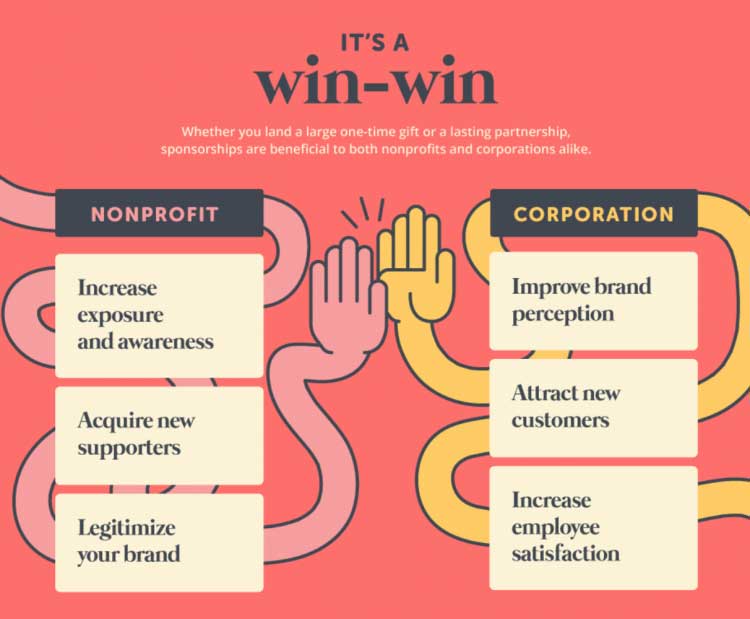Corporate Sponsorships for Nonprofits: The Basics

Request a Demo
Learn how top nonprofits use Classy to power their fundraising.
As a nonprofit fundraiser, you know the value of individual donations and grants, but another source of income to consider is corporate sponsorship. Many nonprofits have effectively leveraged corporate sponsorships to increase revenue and develop relationships with well-heeled prospects. In this post, we will examine some common assumptions about corporate sponsorships for nonprofits as well as the value and risks that these relationships carry.
What is a Corporate Sponsorship?
Corporate sponsorships can be a valuable source of revenue for nonprofits, big and small. When businesses make contributions to nonprofits, the benefits flow both ways: nonprofits secure critical funding to make headway on their mission while corporations improve their brand reputation and attract new supporters. Corporate sponsorships can involve different kinds of support, from matching campaigns and large financial gifts to marketing initiatives and employee giving programs. There’s a perfect corporate sponsorship for every nonprofit—just check out our handy infographic about corporate sponsorship to find out more.
Benefits of Corporate Sponsorships
At first glance, a corporate sponsorship may seem like a lofty goal for your nonprofit or business. But a corporate sponsorship is not only possible—it’s also mutually beneficial. These relationships can build visibility, legitimacy, and impact for both parties, improving the corporation’s brand perception while providing your nonprofit with the funding and reach necessary to make good on your mission.
When you partner with a business that aligns with your values, your corporate sponsorship can be a lucrative source of revenue that yields many more rewards than drawbacks. You’ll enjoy the opportunity for large-scale donations and ongoing partnerships that may be otherwise difficult to find within your community as they help expand outreach and reach new audiences. They’ll enjoy a positive public image that boosts employee satisfaction and helps draw in new customers.
Here are just some of the benefits of corporate sponsorship opportunities.
For a nonprofit:
- Increased awareness of your cause
- Boosted visibility for fundraising efforts
- New supporters interested in your mission
- A sense of legitimacy for your organization
For a corporation:
- Elevated public perception
- Increased satisfaction of current customers
- New customers interested in your brand
- Boosted employee morale
How to Ask for Corporate Sponsorships
If you feel daunted by soliciting corporate sponsorships, just remember that these relationships are in corporations’ best interest and yield benefits for them. Before you approach prospective sponsors:
- identify businesses that align with the causes and values of your nonprofit.
- Start your search with for-profit companies that share a similar audience or work with products related to your nonprofit.
- Once you’ve found the right match, research the person or department responsible for sponsorships, and don’t be afraid to use mutual contacts to make the first introduction.
- Then, prepare a professional and engaging pitch that speaks to how a potential partnership could help enhance your reach and their reach. Searching for a sponsor for an online or hybrid event? Check out our tips for how to solicit corporate sponsorships for your virtual fundraising events.
How to Form Relations with Corporate Sponsorships
You’ve mastered the art of pitching to corporate sponsors and delivered a dynamic pitch that shows how your brand objectives align, highlights the mutually beneficial aspects of the sponsorship, and offers feasible examples of initiatives to illustrate a potential pathway forward. Afterward, you followed up with the business to thank them for their time and keep the conversation going. Now that the sponsorship is in the books, you’ll want to continue working proactively with your partner. Schedule regular meetings to review expectations, roles, and tactics and speak openly about any changes or developments. Show them how much you value their support and what their sponsorship means for your cause. With consistent, transparent communication, you can form a solid foundation to build future initiatives.
Common Assumptions of Corporate Sponsorship
While it may seem like a no-brainer to launch any initiative that can increase revenue, sometimes nonprofits actually avoid corporate sponsorships due to a handful of negative connotations. Perhaps you have concerns about taking on more taxable income. Or, you’re worried that you’ll never find a for-profit business that aligns with your values and your fundraising goals. Or, maybe you’re afraid that even if you do find the perfect partner, they won’t feel the same way. Rest assured—while these assumptions may be common, they’re just that: assumptions. Let’s debunk these misconceptions so you can tap into the power of corporate partnerships.
“A Corporate Sponsorship Is Just a Contribution a Business Makes to My Nonprofit.”
Sort of, but there’s more to it.
Sponsorship payment is where the corporation contributes to a nonprofit organization without a substantial gain in return. Legitimate corporate sponsors provide tax benefits to the business, help fund the nonprofit, and avoid classification as unrelated business income (which is subject to taxation). To maintain these sponsorship benefits without compromising the tax status of the contribution, the nonprofit needs to avoid “advertising” for the business in return for the contribution.
Sponsors can be recognized by the organization, but this recognition must not endorse the corporate sponsor‘s product, use comparative language, or mention price information. Once you cross into advertising for the sponsor, the contribution becomes taxable income.
“Who Would Want to Sponsor Us Anyway?”

A nonprofit sponsorship opportunity may seem unattainable for smaller organizations, but the continued emphasis on corporate giving and the wide variety of businesses willing to become sponsors makes it feasible at any level. Local businesses may be looking for ways to increase their visibility and public awareness, and larger businesses often seek to soften an austere image by working with charities.
Before approaching a potential sponsor, think about the demographics of your community and which businesses would like to reach this target audience. Your best bet is to seek sponsors whose business relates to your cause and brand image. For example, it makes sense for a pet food company to sponsor a community animal shelter.
Once you’ve identified a list of prospects, whether, through alignment with your cause or personal contacts, you will need to spend some time thinking about the value proposition for the prospective sponsor you will approach. What is their incentive for giving?
One attractive option to explore is pitching businesses on sponsoring “matching donation” periods during your next peer-to-peer fundraising campaign. This allows you to maximize the impact of the potential sponsor‘s gift (by providing further incentives to individual donors), and it helps expose the sponsor’s brand to potential consumers (using Classy’s donation matching feature, you can automatically display a sponsor’s logo on your donation site whenever a gift is matched).
“Corporate Sponsorships Can Tarnish the Image of a Nonprofit Organization.”
There’s no question about it, a poor partnership can damage an organization’s image and diminish public support. The American Academy of Family Physicians was criticized in 2010 for partnering with Coca-Cola.1 The corporate partnership came under scrutiny because of the conflict between the AAFP’s mission and the perception of soda as contributing to obesity.
Controversies like these affirm the importance of finding a compatible corporate partnership. Ask yourself if there are conflicts between your organization’s and the sponsor’s values and mission. It’s also a good idea to do some research on the sponsor’s reputation or past charitable gifts. Check out these corporate sponsorship examples that ended up being successful in garnering additional ideas about how to go about establishing a relationship with a corporate sponsor for your nonprofit.
On the other hand, research has shown that nonprofits are seen as less competent than for-profit businesses. The right sponsorship opportunity could lend an aura of enhanced credibility to a lesser-known organization.
“We Can Get Funds Elsewhere Without the Risk of Aligning With a Corporation.”
Of course, you can forego the risk of aligning your nonprofit with another brand by simply focusing on other sources of income. But there are additional benefits to a corporate sponsorship that may be worth the risk.
One of the most important results of a partnership is that both parties reach new audiences. You can bet that businesses will want people to know about their philanthropy. Greater visibility can lead to new donors and volunteers, both from the public and the sponsor’s employees.
Ultimately, the choice is yours, but it’s one worth thinking about. If you can develop the right relationships to secure corporate sponsorships for your nonprofit, the rewards can be significant.
Classy Can Help
If you are on a mission to secure a corporate sponsorship for your nonprofit organization, let Classy help you take the first steps. Using our platform, level up your fundraising campaigns and enhance the giving experience by meeting your supporters where they are. Before you know it, you can begin creating the impact that you have always dreamed of for your nonprofit by securing corporate sponsorships with partners who support your mission day in and day out.
Sources:

The Guide to Pitching Corporate Sponsors
Subscribe to the Classy Blog
Get the latest fundraising tips, trends, and ideas in your inbox.
Thank you for subscribing
You signed up for emails from Classy
Request a Demo
Learn how top nonprofits use Classy to power their fundraising.


